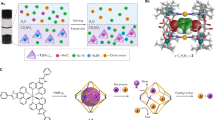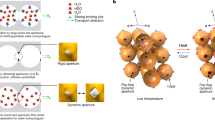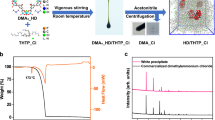Abstract
The separation of molecules with similar size and shape is an important technological challenge. For example, rare gases can pose either an economic opportunity or an environmental hazard and there is a need to separate these spherical molecules selectively at low concentrations in air. Likewise, chiral molecules are important building blocks for pharmaceuticals, but chiral enantiomers, by definition, have identical size and shape, and their separation can be challenging. Here we show that a porous organic cage molecule has unprecedented performance in the solid state for the separation of rare gases, such as krypton and xenon. The selectivity arises from a precise size match between the rare gas and the organic cage cavity, as predicted by molecular simulations. Breakthrough experiments demonstrate real practical potential for the separation of krypton, xenon and radon from air at concentrations of only a few parts per million. We also demonstrate selective binding of chiral organic molecules such as 1-phenylethanol, suggesting applications in enantioselective separation.
This is a preview of subscription content, access via your institution
Access options
Subscribe to this journal
Receive 12 print issues and online access
$259.00 per year
only $21.58 per issue
Buy this article
- Purchase on Springer Link
- Instant access to full article PDF
Prices may be subject to local taxes which are calculated during checkout






Similar content being viewed by others
References
Kerry, F. G. Industrial Gas Handbook: Gas Separation and Purification (CRC Press, 2007).
Darby, S. et al. Radon in homes and risk of lung cancer: Collaborative analysis of individual data from 13 European case-control studies. Br. Med. J. 330, 223–227 (2005).
Turkevich, A., Winsberg, L., Flotow, H. & Adams, R. M. The radioactivity of atmospheric krypton in 1949–1950. Proc. Natl Acad. Sci. USA 94, 7807–7810 (1997).
Bowyer, T. W. et al. Elevated radioxenon detected remotely following the Fukushima nuclear accident. J. Environ. Radioact. 102, 681–687 (2011).
Rutherford, E. Absorption of the radio-active emanations by charcoal. Nature 74, 634 (1906).
Munakata, K. et al. Adsorption equilibria of krypton, xenon, nitrogen and their mixtures on molecular sieve 5 Å and activated charcoal. J. Nucl. Sci. Technol. 36, 818–829 (1999).
Gaul, W. C. & Underhill, D. W. Dynamic adsorption of radon by activated carbon. Health Phys. 88, 371–378 (2005).
Wright, P. A. Microporous Framework Solids (Royal Society of Chemistry, 2008).
Li, J. R., Kuppler, R. J. & Zhou, H. C. Selective gas adsorption and separation in metal–organic frameworks. Chem. Soc. Rev. 38, 1477–1504 (2009).
Bloch, E. D. et al. Hydrocarbon separations in a metal–organic framework with open iron(II) coordination sites. Science 335, 1606–1610 (2012).
Couderc, G. et al. Reversible sorption of nitrogen and xenon gas by the guest-free zeolite tris(o-phenylenedioxy)cyclotriphosphazene (TPP). Micropor. Mesopor. Mater. 88, 170–175 (2006).
Carta, M. et al. An efficient polymer molecular sieve for membrane gas separations. Science 339, 303–307 (2013).
Van Heest, T. et al. Identification of metal–organic framework materials for adsorption separation of rare gases: Applicability of ideal adsorbed solution theory (IAST) and effects of inaccessible framework regions. J. Phys. Chem. C 116, 13183–13195 (2012).
Mitra, T. et al. Molecular shape sorting using molecular organic cages. Nature Chem. 5, 276–281 (2013).
Bae, Y. S. et al. High xenon/krypton selectivity in a metal–organic framework with small pores and strong adsorption sites. Micropor. Mesopor. Mater. 169, 176–179 (2013).
Wang, H. et al. The first example of commensurate adsorption of atomic gas in a MOF and effective separation of xenon from other noble gases. Chem. Sci. 5, 620–624 (2014).
Liu, J., Strachan, D. M. & Thallapally, P. K. Enhanced noble gas adsorption in Ag@MOF-74Ni. Chem. Commun. 50, 466–468 (2014).
Sikora, B. J., Wilmer, C. E., Greenfield, M. L. & Snurr, R. Q. Thermodynamic analysis of Xe/Kr selectivity in over 137 000 hypothetical metal–organic frameworks. Chem. Sci. 3, 2217–2223 (2012).
Liu, J., Thallapally, P. K. & Strachan, D. Metal–organic frameworks for removal of Xe and Kr from nuclear fuel reprocessing plants. Langmuir 28, 11584–11589 (2012).
Tozawa, T. et al. Porous organic cages. Nature Mater. 8, 973–978 (2009).
Willems, T. F. et al. Algorithms and tools for high-throughput geometry-based analysis of crystalline porous materials. Micropor. Mesopor. Mater. 149, 134–141 (2012).
Haldoupis, E., Nair, S. & Sholl, D. S. Pore size analysis of > 250,000 hypothetical zeolites. Phys. Chem. Chem. Phys. 13, 5053–5060 (2011).
Yang, L. et al. Synthesis and characterization of a new structure of gas hydrate. Proc. Natl Acad. Sci. USA 106, 6060–6064 (2009).
Ohgaki, K., Sugahara, T., Suzuki, M. & Jindai, H. Phase behavior of xenon hydrate system. Fluid Phase Equilib. 175, 1–6 (2000).
Fogarty, H. A. et al. A cryptophane core optimized for xenon encapsulation. J. Am. Chem. Soc. 129, 10332–10333 (2007).
Fairchild, R. M. et al. A water-soluble Xe@cryptophane-111 complex exhibits very high thermodynamic stability and a peculiar 129Xe NMR chemical shift. J. Am. Chem. Soc. 132, 15505–15507 (2010).
Taratula, O. et al. Crystallographic observation of ‘induced fit’ in a cryptophane host–guest model system. Nature Commun. 1, 148 (2010).
Parkes, M. V. et al. Screening metal–organic frameworks for selective noble gas adsorption in air: Effect of pore size and framework topology. Phys. Chem. Chem. Phys. 15, 9093–9106 (2013).
Perry, J. J. et al. Noble gas adsorption in metal–organic frameworks containing open metal sites. J. Phys. Chem. C 118, 11685–11698 (2014).
Simgen, H. Radon assay and purification techniques. AIP Conf. Proc. 1549, 102–107 (2013).
Lorenz, H. & Seidel-Morgenstern, A. Processes to separate enantiomers. Angew. Chem. Int. Ed. 53, 1218–1250 (2014).
Hasell, T. et al. Porous organic cage nanocrystals by solution mixing. J. Am. Chem. Soc. 134, 588–598 (2012).
Dubbeldam, D., Torres-Knoop, A. & Walton, K. S. On the inner workings of Monte Carlo codes. Mol. Simul. 39, 1253–1292 (2013).
Dubbeldam, D., Calero, S. & Vlugt, T. J. H. Exploring new methods and materials for enantioselective separations and catalysis. Mol. Simul. 40, 585–598 (2014).
Hasell, T. et al. Reversible water uptake by a stable imine-based porous organic cage. Chem. Commun. 48, 4689–4691 (2012).
Liu, M. et al. Acid- and base-stable porous organic cages: Shape persistence and pH stability via post-synthetic ‘tying’ of a flexible amine cage. J. Am. Chem. Soc. 136, 7583–7586 (2014)10.1021/ja503223j
Seo, J. S. et al. A homochiral metal–organic porous material for enantioselective separation and catalysis. Nature 404, 982–986 (2000).
Kim, K., Banerjee, M., Yoon, M. & Das, S. Chiral metal–organic porous materials: Synthetic strategies and applications in chiral separation and catalysis. Top. Curr. Chem. 293, 115–153 (2010).
Dybtsev, D. N. et al. A homochiral metal–organic material with permanent porosity, enantioselective sorption properties, and catalytic activity. Angew. Chem. Int. Ed. 45, 916–920 (2006).
Liu, B. Metal–organic framework-based devices: Separation and sensors. J. Mater. Chem. 22, 10094–10101 (2012).
Xuan, W. et al. A chiral quadruple-stranded helicate cage for enantioselective recognition and separation. J. Am. Chem. Soc. 134, 6904–6907 (2012).
Li, P. et al. A homochiral microporous hydrogen-bonded organic framework for highly enantioselective separation of secondary alcohols. J. Am. Chem. Soc. 136, 547–549 (2014).
Hasell, T. et al. Controlling the crystallization of porous organic cages: Molecular analogs of isoreticular frameworks using shape-specific directing solvents. J. Am. Chem. Soc. 136, 1438–1448 (2014).
Hasell, T., Zhang, H. & Cooper, A. I. Solution-processable molecular cage micropores for hierarchically porous materials. Adv. Mater. 24, 5732–5737 (2012).
Brutschy, M., Schneider, M. W., Mastalerz, M. & Waldvogel, S. R. Porous organic cage compounds as highly potent affinity materials for sensing by quartz crystal microbalances. Adv. Mater. 24, 6049–6052 (2012).
Mastalerz, M., Schneider, M. W., Oppel, I. M. & Presly, O. A salicylbisimine cage compound with high surface area and selective CO2/CH4 adsorption. Angew. Chem. Int. Ed. 50, 1046–1051 (2011).
Mastalerz, M. Shape-persistent organic cage compounds by dynamic covalent bond formation. Angew. Chem. Int. Ed. 49, 5042–5053 (2010).
Zhang, G. et al. A permanent mesoporous organic cage with an exceptionally high surface area. Angew. Chem. Int. Ed. 53, 1516–1520 (2014).
Zhang, G. et al. A shape-persistent quadruply interlocked giant cage catenane with two distinct pores in the solid state. Angew. Chem. Int. Ed. 53, 5126–5130 (2014).
Acknowledgements
We thank EPSRC (EP/H000925/1; EP/K018396/1), the European Research Council under FP7 (ERC grant agreement no. 321156) and Region PACA (Provence-Alpes-Cote-d’Azur) for funding. A.I.C. is a Royal Society Wolfson Merit Award holder. K.E.J. is a Royal Society University Research Fellow. We thank Diamond Light Source for access to beamlines I11 (EE7040) and I19 (MT8728) that contributed to the results presented here. We also thank the beamline staff for their assistance during the I11 experiments. We thank D. Dubbeldam for providing the RASPA simulation package. We thank the US Department of Energy (DOE), Office of Nuclear Energy, and in particular, J. Bresee, for their support. T. Todd (Idaho National Laboratory) and B. Jubin (Oak Ridge National Laboratory) provided programmatic support and guidance. Pacific Northwest National Laboratory is a multiprogram national laboratory operated for the US Department of Energy by Battelle Memorial Institute under Contract DE-AC05-76RL01830.
Author information
Authors and Affiliations
Contributions
L.C., D.H. and K.E.J. performed the molecular simulations. P.S.R., J.L., D.M.S. and P.K.T. conceived and carried out the gas breakthrough measurements. S.Y.C. and M.A.L. carried out X-ray structure analyses. T.H., K.M.T., J.A.A. and J. Bell performed gas sorption analyses. R.N. and J. Busto carried out the radon adsorption measurements. A.K., M.E.B. and A.S. determined chiral selectivities. A.K., A.S., M.A.L., M.E.B., P.S.R., S.Y.C., and T.H. prepared the cage molecules. A.I.C. conceived the project. All coauthors contributed to the writing of the paper.
Corresponding author
Ethics declarations
Competing interests
The authors declare no competing financial interests.
Supplementary information
Supplementary Information
Supplementary Information (PDF 8685 kb)
Rights and permissions
About this article
Cite this article
Chen, L., Reiss, P., Chong, S. et al. Separation of rare gases and chiral molecules by selective binding in porous organic cages. Nature Mater 13, 954–960 (2014). https://doi.org/10.1038/nmat4035
Received:
Accepted:
Published:
Issue Date:
DOI: https://doi.org/10.1038/nmat4035
This article is cited by
-
Self-similar chiral organic molecular cages
Nature Communications (2024)
-
Polycage membranes for precise molecular separation and catalysis
Nature Communications (2023)
-
Boosting xenon adsorption with record capacity in microporous carbon molecular sieves
Science China Chemistry (2023)
-
Assembling ionic liquid into porous molecular filler of mixed matrix membrane to trigger high gas permeability, selectivity, and stability for CO2/CH4 separation
Nano Research (2023)
-
Sulfonylcalix[4]arene-based metal-organic polyhedra with hierarchical porous structures for efficient Xe/Kr separation
Nano Research (2023)



